The Destituent Moment of the Chilean October
Interview with philosopher Rodrigo Karmy
In recent months there has been a lot of talk about the rupture that occurred October 18 in Chile. There may be no better chronicle of these events than El porvenir se hereda: fragmentos de un Chile sublevado (The Future is Inherited: Fragments of the Chilean Uprising, 2019), by the Chilean philosopher Rodrigo Karmy, a singular book that readily offers an insightful look at the October and November sequence with a reflexive density that anticipates the different conditions needed for inhabiting the fragmentation of the world.
This constellation approaches the Chilean revolt with a pathos of distance, abandoning the typical labels and packaging used to reduce the turbulence of such a large-scale event. In his writing, Karmy is interested in freeing the destituent and experiential energy of the revolt that disrupts the urban space and its codes. In this way, he shows how life and thought connect, and how that connection is broken by the instrumental prison of every “master” signifier. This, perhaps, is the Chilean moment’s challenge for any thought that claims to be liberated and devoid of internal barriers.
Rodrigo Karmy is professor of Philosophy and Arabic Studies at the University of Chile. He is the author of Políticas de la ex-carnación (Politics of Excarnation, 2014), Escritos bárbaros (Barbarian Writings, 2018), and more recently Fragmento de Chile (Fragment of Chile, 2019). Karmy is known as one of the “Latin American Averroists.” His writings contain some of the most clear-sighted perspectives on the political situation in Chile and, by extension, the legitimacy crisis of governmentality in the region.
—Gerardo Munoz
Other languages: Español, Français


Rodrigo, first, thanks for taking the time to respond to these questions about the Chilean moment that you worked to elucidate in El porvenir se hereda. Let’s begin with the title itself: faced with a revolt that some have called “experiential,” why return to the topos of the Popular Unity period? Can we speak of a future within the “epochal” interregnum that we are inhabiting currently?
I think that Popular Unity operates like a “never took place” that irrupts from time to time, altering our present. For me, Popular Unity is an experience, an interruption of the Chilean historical continuum and thus a process that exceeds that very continuum. Therefore, in the multiple popular uprisings that have taken place over the last decades, this past resurfaces, no longer in the form of Popular Unity, but in relation to the historic demands and to the collective desires for democratization that were buried with the coup d’état in 1973. It is clear, in this sense, that the heritage of Popular Unity is not the “bad government” that the intellectuals of order attribute to it, but the transmission of a to-come (porvenir) amidst the untimeliness of the present. Despite its philosophy of history, which promised a future and advanced its discourse, the most radical heritage of the UP has never been the “future” but the “to-come;” not a restitution of the continuum, but its interruption, one flooded with a present that is capable of becoming something other than what it is and that cuts through us and blends us with other times and other spaces. We could put it like this: if the “future” implied a philosophy of history in which there was an ideal to be reached, the “to-come” is more of a time in the middle of time, a possibility in the middle of an actuality. What is at issue is not a “beyond” toward which we move, but a possibility that has ripped open the stitching of the securitarian and fascist order in which we live.
There are several parallels between the Yellow Vests and the Chilean October. We could perhaps speak of a new “politics of experience” that cannot be reduced to the mere occupation of squares, as happened in the 2011 movements, nor can it be reduced to the “equivalential demands” of populist logic. All the statements in the Chilean revolt carry within them a powerful charge of experience that moves against the political establishment: “evasion” (at first physically, sidestepping the metro turnstiles, then figuratively, dodging the whole system), “it’s not about 30 pesos, it’s about 30 years,” “we’re not at war,” etc. To what extent can we speak of this experiential dimension as a higher phase of the “horizontal” revolts of occupation? Does the novelty lie in this shift between phases?
Maybe. We could say that the irruption of experience as a political field is not a “higher phase” but precisely a “lower phase,” what Benjamin might have called a “weak” response that never allows itself to be reduced to the populist logic’s “demands for equivalence” and its institutional politics. When high school students say “evade” and invoke “no fear” as an attitude against power, they turn the political moment into a destituent festival where images regain their life and bodies regain their strength. Life sees to it that imagining, acting and thinking come together in a single intensity and that bodies break down the mechanisms that subdue them. In this sense, it seems to me that the novelty is that the revolt emerges without a philosophy of history, in a properly comic gesture that does not even attempt to seize power or to negotiate with it, but rather to lay it bare, to expose its radically arbitrary character, its lack of any foundation. In other words, the experience of popular insurrection takes on a destituent character (as Agamben suggests, picking up the trail where Benjamin left it with respect to power (potencia), or Lacan with respect to the clinic) in which power-knowledge is deposed, and in which the people assume, for once, that there is nothing and no one “behind” (or beyond) it coming to save them.
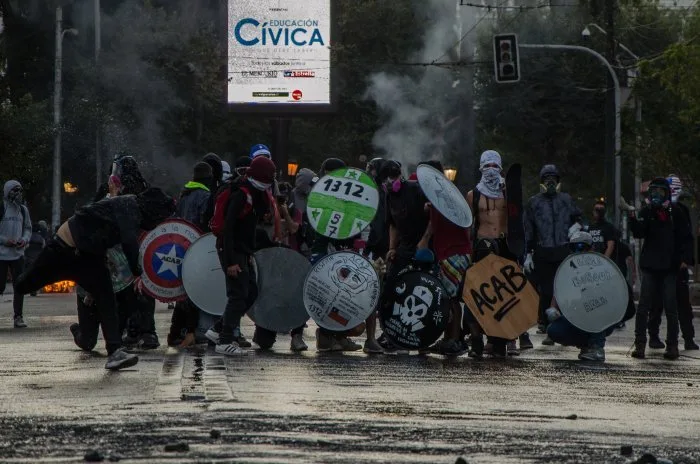
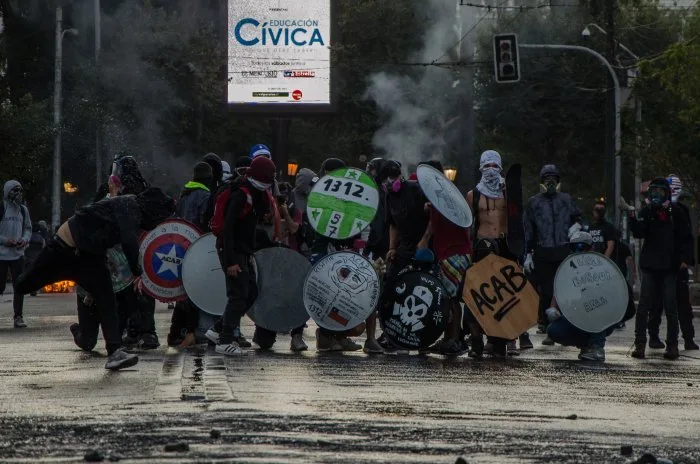
But there are branches and bifurcations in the temporal sequence of the uprising. In what sense does 2019 traverse and cut into the important 2011 student movement?
We could put it like this: the student movement was the first radical challenge to Pinochet’s constitutional order, but was the last form of “pastoral” protest. In this case, it was the students who led the process and their political leaders who acted as interlocutors with the governments of the day. There was Camila Vallejo, Giorgio Jackson and others. By October 2019, however, we have no faces, and in fact, we are witnessing an implosive logic every time “somebody” tries to capitalize on the revolt. In other words, the Nietzschean term “twilight” is still far too progressive: here, every leader “crashes” and sinks into the chain of events of a revolt that no one controls, directs, or leads. Today, the nobodies have regained their power, and “dialogue” with state interlocutors is no longer possible, since any form of negotiation with the State presupposes the construction of a system of equivalences that has been blown sky high.
To obstruct equivalence, you have to block the flows of the metropolis. Here the problem of space is decisive. Some have said1 that it is no coincidence that what set off the revolt had to do with El Metro de Santiago – the mesocratic symbol of the capital city. This opens a discussion on the organization and infrastructure of territories in a time when apparatuses seek to govern through territoriality, population statistics, and infrastructure. Can we speak today of a revolt against all that the design of the metropolis entails?
In a sense, yes. Chile has a singular, subterranean very important history of democratic articulation which, since before the Republic, has passed through the constitution of cabildos, or town halls. If modern revolutions have the Councils as the basic organizing device that catalyzes their processes, the Latin American republics, and Chile in particular, have the cabildos as collective deliberative bodies that challenge the centrality of power. What happened is that the Republic was born from the cabildos, but that these were later replaced by the monopoly of the Republic itself, the latter now identifying, without the slightest fissure, with the State and its “Portalian” matrix. Diego Portales – a 19th-century tobacco entrepreneur – imposed an authoritarian State model explicitly premised on a supposed “lack of civic virtues.” This model, it seems to me, has remained in force in each renewal of the oligarchic pact crystallized in the various political constitutions, including that of 1980, currently in force. They all maintained this centralist view. And today, with the multiplication of cabildos2 and citizens’ assemblies, we are witnessing the reappraisal of this “Portalian” matrix that the civil-military dictatorship left us as its heritage. The cabildo is the sign of the existence of a collective assemblage that today is being revitalized with the revolt.


In your book you evoke a very beautiful hypothesis: the power of rhythm at the heart of the movement. A rhythm that is not a mere sequence of subjects, but the transfiguration of time itself in relation to action; as if, in some way, the mediation between not only institution and movement, but also between action and imagination, between the sensible plane and the spatial plane were suspended. Could you delve a little deeper into this hypothesis to help us understand how these last months unfolded?
There’s probably a lot to be said for the rhythmicity of the revolt. For now, let me simply evoke the existence of what I have called “rhythmic markers” that define or, rather, organize the becoming of the revolt. Following certain readings, I would say that the rhythmic markers are the strategic functioning of a revolt in a scenario where there is no vanguard planning it. When you have a vanguard, it is the subject “supposed to know” that plots out the strategy. When no vanguard exists, it is various waves of imagination that give the revolt its rotating rhythmic marker: it was the high school students appearing suddenly out of the underground of the metro, followed by the feminist movements, that marked the rhythm of the revolt. There is a permanent rotation between movements that are visible as precise waves that appear and disappear, showing up then slipping away. I think this is what we could define as rhythm: a wave of popular imagination in which an irruption takes on various faces, rotating multiple forms without any of them being able to completely capture the process. For example, at a time when the revolt was being heavily criminalized by the government, Las Tesis appeared and with their choreography pulled the revolt out from the trap laid by power and, for a moment, deactivated the “friend-foe” cleavage imposed by state rationality.
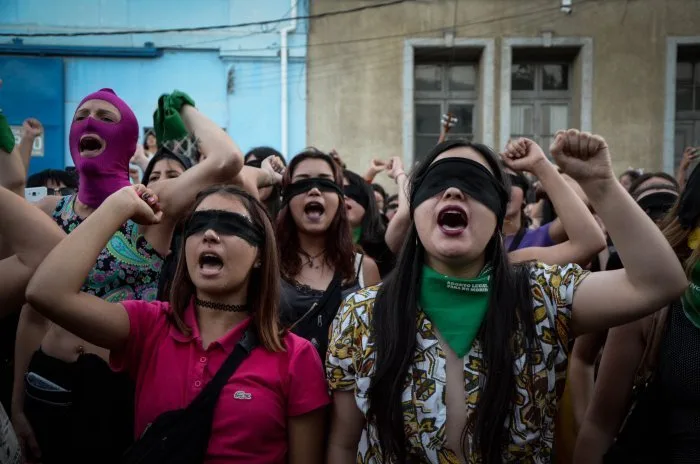

Another category that emerges in your cartography, and to which you have already alluded several times, is the question of “imagination.” Obviously, the use of imagination has nothing to do with the 1968 slogan, “all power to the imagination.” Instead, it is more of an “Averroist” topos. In what sense can we speak of this revolt like a breach in the common imagination?
This is an essential question. Especially since revolt functions as a sort of threshold from which imagination is no longer seen as a psychological faculty safely situated inside the subject (what Henri Corbin called “imaginary”) in order to externalize into a transformative force that passes through us and in which we dwell (which, in its own right, becomes “creative” and which Corbin would have called “imaginal”). The revolt restores to imagination its character as an “interworld” in which past and present radically coalesce, configuring what Furio Jesi called the “point of intersection,” or what Corbin referred to as an “imaginal world.” Imagination as a place without place – a proper khôra – is precisely what is actualized here and allows us to understand something crucial: that acting, thinking, and imagining are three terms the philosophical tradition usually separates, but which, strictly speaking, should be thought of as three modes of the same intensity. In this sense, I think that revolt allows us to understand that the problem of imagination is always both ethical and political at the same time. Thus, for example, when the country’s cities are taken over with tagged walls, murals, improvised memorials, or when various rhythmic markers accelerate or slow down the dancing of the bodies of the people uprising, only then do we encounter this explosion of the common imagination that overwhelms and dismantles everything.
Now that you have said “dismantle,” I think that another plane of inscription for this revolt is what you have termed, following Agamben and others, a “destituent power.” We know that throughout the twentieth century, revolutionary technique presupposed a horizon devoted to the projection of “objectives”: to occupy the state, and do so with government mandate. In your view, what is at stake in the destituent gesture as expressed in the Chilean moment?
I think that what is at stake is the very implosion of the pastoral paradigm that has articulated modern forms of government for a millennium. The fact that vanguards have become superfluous, and the trouble political parties or social organizations are having as they try to play the role of leaders of the process – and even the obsessive way the establishment intellectuals have sought out a leadership or some vanguard they suppose to be the driving force behind things (for example, attempting to identify “anarchist” groups “behind” the revolt, even though in this revolt, there is no one “behind” the scenes calling the shots) – all of this has everything to do with this problem. This lack of pastoral leadership is made up for by the rhythmic markers that have provided forms of organization that are parallel to established institutions (like the cabildos) and temporalities that are alternatives to this institutionalization. The general strike or other forms of protest have interrupted the temporality of capital which, as we know from Foucault’s lectures, ultimately responds to a properly pastoral rationality. In this sense, I think it is not by chance that, after years of dismantling the legitimacy of the Church, this revolt has emerged, assuming that the Church (as Freud and Schmitt think) functions as a formal paradigm of modern institutions.


Indeed, there has been a lot of anxiety in the status quo about the destituent hypothesis. They have even gone so far as to call it a “new party of violence,” which resonates with some of the proposals from some French friends 3. It would seem that in an anarchic epoch, the right and its guardians are only capable of deepening an administration of war using a system of fear. How does your understanding of the Chilean October lead you to interpret this anxious effort to administer a stasis?
I can respond with a recent anecdote: two “establishment intellectuals” referred to a small text called “The Destituent Moment” that I penned about one of the first big marches that have taken place in Plaza Dignidad since October 18. The first is a social democrat, José Joaquín Brunner, who rightly criticized me in an editorial for belonging to the “party of violence.” The second is an ultra-right-wing reactionary, Gonzalo Rojas, who accused me in another editorial of being a “destroyer” of all institutionality. Three things appear interesting to me here. First, despite their ideological differences, both display the same inability to understand what destitution is, identifying it with the cleavage of their own design that is “destruction.” Next, despite their ideological differences, both are entrenched in a shared taste for the common enemy that they intend to sacrifice as a public enemy by accusing it of promoting violence and seeking to destroy the order of things. Finally, there was this fixation on the text they both exhibit, which is only one element in a rather vast series of things I have been writing for the last few years. It is as if they saw something monstrous in the term “destitution,” something that they cannot deal with except by reducing it to the field of a purely sacrificial violence or mythical violence, as Benjamin said. That they shared the same attitude is explained by the fact that they both are “intellectuals of the order” instituted since Pinochet, who either defend the transition (Brunner) or defend Pinochetism (Rojas) as the mythical nucleus of that transition. There is a secret complicity between the two through the so-called “democracy of agreements,” which entailed the demobilization of the popular uprisings that ended the dictatorship and the reforms to the Constitution. But they did not do away with the neoliberal doctrinal matrix of the dictatorship. I think that revolt does not destroy. Precisely because it is not a vanguard, it profanes.
We might say that, whereas revolution (at least in its modern form) harbors destructive violence because it gets involved with a particular vanguard, revolt opens onto a destituent violence precisely because it does not tie itself to any vanguard and instead entirely embraces the rhythm of bodies. Revolt is always much more precarious, weaker if you like, in the sense that it cancels the usual way of things, denaturalizing them, so as to imagine other possible uses. And therein lies the risk this power assumes, because constituted power will always accuse it – as Benjamin knew – of being “anarchist, nihilist and senseless.” Revolt, then, does not obey the liberal paradigm of peace any more than it obeys the sovereigntist notion of destruction. For this reason, it does not submit to the civilizational paradigm of “civilization-barbarism,” but deactivates it, constituting a common field that exceeds that very cleavage. And therein lies its singularity. Certainly, it always runs the risk of falling into these positions, but its rhythmic markers, when they occur, pull it back from those threats. It is for this reason that I refuse to play the game of equivalences and to maintain – in the brutal and irresponsible manner of intellectuals who, from their illusory academic position, demand a sense of responsibility from others – that the violence of this revolt is equivalent to that which took place during the coup d’état of 1973. Not at all! The violence of the oppressed – which exists, which happens – is destituent but never destructive.
I think that this point is also important when we consider the various leftisms whose liberalization has denied every possibility of thinking through violence: the left must recognize (as did Marx, Lenin, et al.) that popular violence exists and that, nevertheless, it is the result of a very different context than that of oppressive violence. Following the Benjaminian trace, this popular violence, however, is not “justifiable” in the sense that it is not subject to the scheme of means and ends, and for this very reason it acquires a destituent character. I think we should insist on the violence of resistance, on the violence entailed in rising up to revolt, but at the same time, we must make sure this violence remains destituent and that it implodes the sacrificial scheme of the violence of oppression. Otherwise, the discourse of equivalences ends up neutralizing the destituent power at stake, by re-establishing the violence of the pastoralism referred to above. But also because, often, the violence of the oppressed begins to replicate to the violence of the oppressors, and in the moment of triumph, an order is established just as brutal as the one that preceded it (this is something that Franz Fanon observed during the experience of Algerian decolonization). This is why, for the oppressed, the work of critique is decisive (what Furio Jesi called “demythologization”) if we do not wish to succumb to the false myths of capital.


It is hard to imagine a phase that goes from destitution to constitution. We should even ask ourselves whether this is possible, or even desirable, since the constituent has historically been a trap of democratic illusions, to echo Mario Tronti. But the moment perhaps calls for another question: what is at stake in the constituent phase that begins in April? Is not all constitutionalism incitement for a program that seeks evasion from the system of production and the cybernetic dominion that govern through the control of flows, and that for this very reason can dispense with the mediation of representation?
Yes, I agree with both points: 1) that there is no possible “mediation” between destitution and the constituent process (ergo, we cannot think of this process in a dialectical mode); and 2) that the transformation of the constitutional question does not necessarily revoke the biopolitical dimension. As to the first point, I believe it is indispensable to think of two logics that operate at the same time: following the trail of Deleuze and Guattari, you find a nomadic logic and a sedentary logic that lie entirely intersected. Because a revolt without any “behind” becomes nothing more than the surface of forces capable of deactivating this intersection, leaving the nomadic logic of the market without the capacity to produce capital, and the sedentary one without the possibility to manage it. If the nomadic logic of government and the sedentary logic of sovereignty are crossed, revolt burst forth as their most radical implosion. The days of general strikes and marches throughout the country produced the effect of interrupting (evading) the intersection of rationalities, the articulation between the constitutional dimension and the biopolitical dispositifs. Consider this: Article 1 of the 1980 Constitution holds that the family is the “fundamental nucleus” of society. This sets up the whole doctrinal and ideological character of the text that governs us, or, if you like, its condition of economic theology. In this sense, the constitution itself is a biopolitical dispositif that conditions flows and subjectivizes bodies and discourses. Ultimately, what is the State? It is not the idol that some “vulgar” anarchists and some radical neoliberals think it is, but nothing more than a set of governmental procedures that operate on the surface of bodies. Interrupting this scenario and cutting the nexus that ties together what Agamben calls the “machine” may be the most effective weapon of the uprising and, it seems to me, what is at stake in Chile.
How to think the constituent process? First of all, not with the notion of constituent power that always – whether Negri likes it or not – propels us toward the State, but with the gamble on a destituent power that can deactivate the prevailing forms by inventing new uses. Destitution is not a “negative” attitude, but an “affirmative” one, insofar as, by denaturalizing the order of things, it makes it possible to wager on a form of life. And that for me is key: the intellectuals of order have not stopped asking themselves, “what is being done to generate credibility”? This is not a political but a theological line of questioning. Instead, we should proclaim Nietzsche’s gamble in his Antichrist when he said that we “do not need another faith but a new form of life.” Only a truly popular imagination can offer us a form of life and not a new (old) faith. Because it is not a matter of restoring a system of obedience, but of imagining an ethics (ethos) in the strong sense of the term: a common way of life.
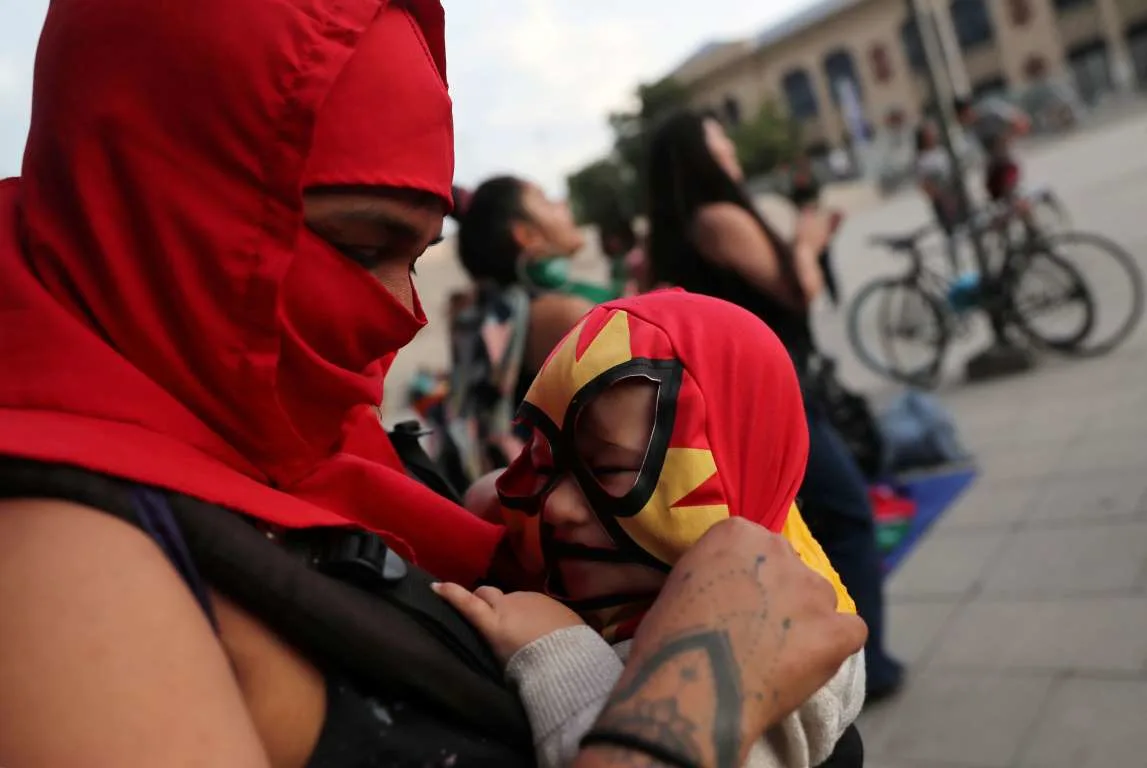
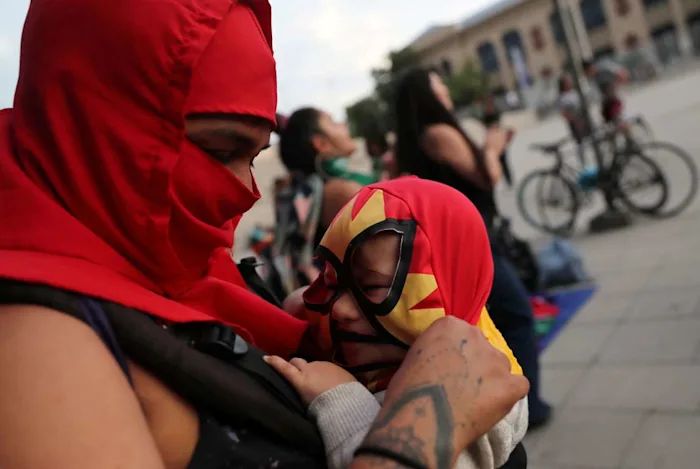
To conclude, the fact remains that we must think about the day after the insurrection, that is, after the warmth of the encounters that took place in October, if not also the times and possibilities that remain open in the rhythms of November. After the French Revolution, Hölderlin spoke of revolutionary energy as a “myth that remains” or a “new religion,” the counterpoint to what you mentioned above about Nietzsche. Myth or institution for this time of assimilation of the revolt and the encounters and connections it made possible? How do you think of the “day after” in line with the destituent hypothesis?
Yes, the “day after” the uprising is the most complex issue because it is the moment of the restitution of historical time. But, there is something key: the first is that, after the burst of revolt, the order of things can persist, but at the price of having lost its capacity for “suggestion,” as Cavalletti would say, or, if you like, hegemony (what is hegemony if not a process of suggestion?). For this reason, often, after revolts (this is what happened with the Arab Spring), counter-revolutionary forces intensify, exposing their violence to the light of day. I think that in Chile something like this can happen: counter-revolutionary forces have been active from day one, provoking a veritable, but soft, coup d’état, not only to re-establish the instituted order, but to accelerate its consolidation. Exceptional measures are intensifying, precisely because hegemony has imploded and power has been unmasked. But such unmasking does not reveal the “truth” hidden behind power as a certain leftism with its police epistemology would like to think. Rather, it reveals other truths, and the first truth is that power is empty and can only function on the common surface of bodies, in its microphysics, weaving forms and harnessing forces. As if revolt were an X-ray machine that reveals that there was nothing to reveal, that shows that there was nothing to show and that nothing and no one was there to erect knowledge about us, to act in our place. Revolt has given them an explosive knowledge from which anyone can blow the so-called subject out of the framework of power. Indeed, as you say in quoting Hölderlin, revolt remains as a power in which we dwell, or rather, in which we camp. Because, despite the restoration of order and with it the restoration of its historical continuum, things will never be the same as before. It remains like danger, because danger remains as revolt.


Interview by Gerardo Muñoz
Translation by Joshua Richeson, with the aid of Cristóbal Grebe
Notes
Gerardo Muñoz teaches at Lehigh University (Pennsylvania, USA). His most recent publications are Por una política posthegemónica (DobleA editores 2020), and the forthcoming edited volume La rivoluzione in esilio: Scritti su Mario Tronti (Quodlibet, 2020).1. Hugo E. Herrera, Octubre en Chile : Acontecimiento y comprensión política : hacia un republicanismo popular. Katankura Editorial, 2019.↰
2. The cabildos were institutions of colonial administration at the municipal level. During the process of emancipation from colonial Spain, open cabildos with forms of popular participation played a decisive revolutionary role by enacting the destitution of the colonial authorities in order to establish autonomous councils.↰